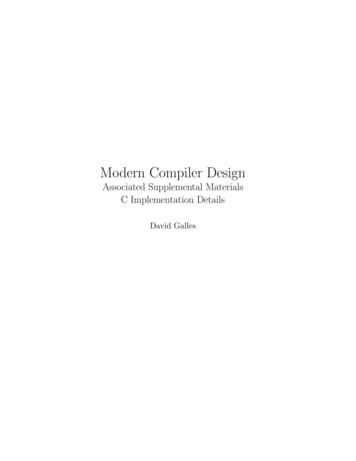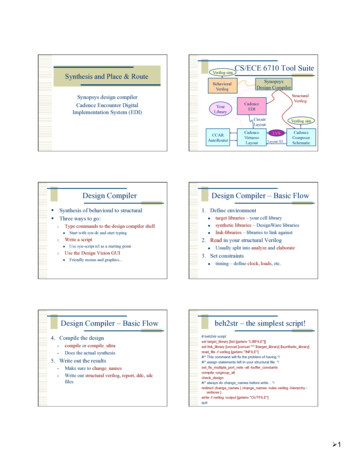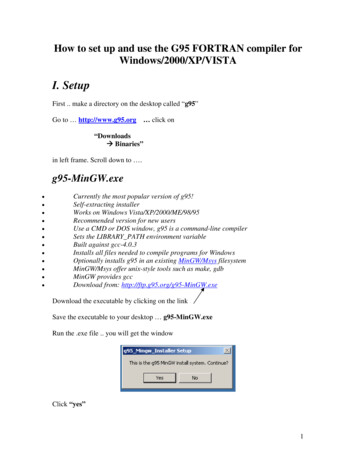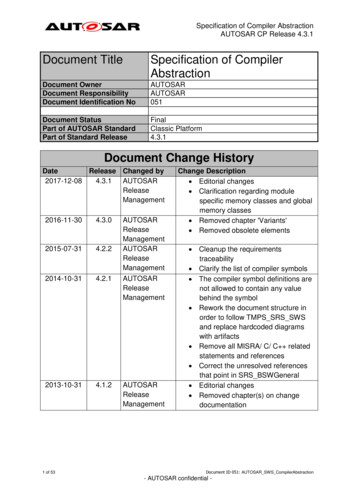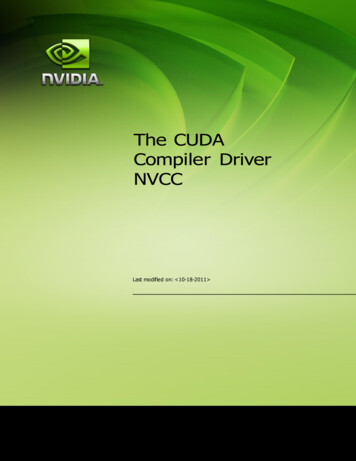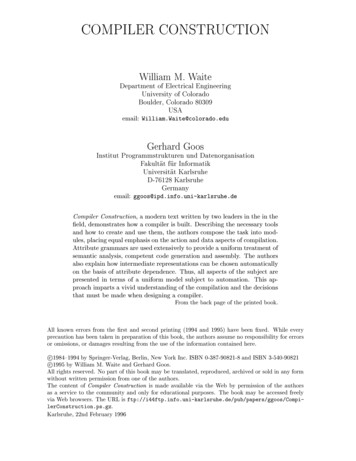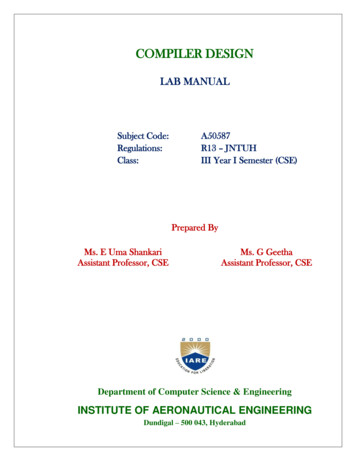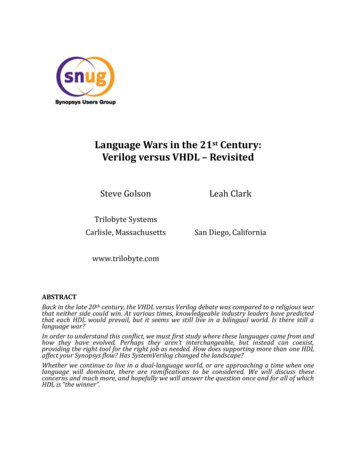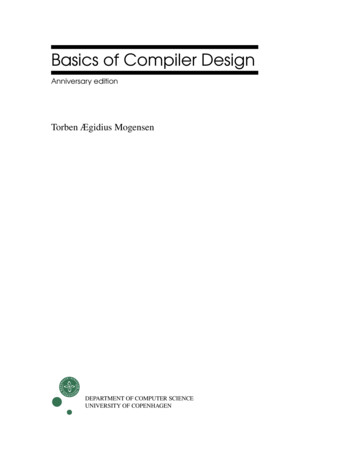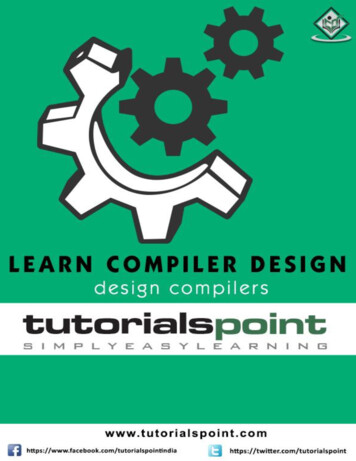
Transcription
Compiler Designi
Compiler DesignAbout the TutorialA compiler translates the codes written in one language to some other language withoutchanging the meaning of the program. It is also expected that a compiler should make thetarget code efficient and optimized in terms of time and space.Compiler design principles provide an in-depth view of translation and optimization process.Compiler design covers basic translation mechanisms and error detection & recovery. Itincludes lexical, syntax, and semantic analysis as front end, and code generation andoptimization as back-end.AudienceThis tutorial is designed for students interested in learning the basic principles of compilers.Enthusiastic readers who would like to know more about compilers and those who wish todesign a compiler themselves may start from here.PrerequisitesThis tutorial requires no prior knowledge of compiler design but requires a basic understandingof at least one programming language such as C, Java, etc. It would be an additionaladvantage if you have had prior exposure to Assembly Programming.Copyright & Disclaimer Copyright 2014 by Tutorials Point (I) Pvt. Ltd.All the content and graphics published in this e-book are the property of Tutorials Point (I)Pvt. Ltd. The user of this e-book is prohibited to reuse, retain, copy, distribute or republishany contents or a part of contents of this e-book in any manner without written consent ofthe publisher.We strive to update the contents of our website and tutorials as timely and as precisely aspossible, however, the contents may contain inaccuracies or errors. Tutorials Point (I) Pvt.Ltd. provides no guarantee regarding the accuracy, timeliness or completeness of our websiteor its contents including this tutorial. If you discover any errors on our website or in thistutorial, please notify us at contact@tutorialspoint.comi
Compiler DesignTable of ContentsAbout the Tutorial ··········· iAudience ························· iPrerequisites ··················· iCopyright & Disclaimer ···· iTable of Contents ··········· ii1.COMPILER DESIGN – OVERVIEW ······················· 1Language Processing System ··················· 1Preprocessor ···················2Interpreter bler ker ·····2Loader ····3Cross-compiler ················3Source-to-source Compiler PILER DESIGN –ARCHITECTURE ················· 4Analysis Phase ·················4Synthesis �·················43.COMPILER DESIGN – PHASES OF COMPILER ······ 5Lexical Analysis ···············6Syntax ····················6Semantic Analysis ···········6Intermediate Code Generation ················6Code Optimization ··········6Code Generation ·············6Symbol ILER DESIGN – LEXICAL ANALYSIS ············ 8Tokens ··· 8Specifications of Tokens · 9Alphabets trings ····9Special Symbols ··············9Language COMPILER DESIGN – REGULAR EXPRESSIONS ·· 11ii
Compiler DesignOperations s edence and Associativity ················126.COMPILER DESIGN – FINITE AUTOMATA ········· 13Finite Automata Construction ··············· 13Longest Match Rule ······ 147.COMPILER DESIGN – SYNTAX ANALYSIS ··········· 15Context-Free Grammar · 15Syntax Analyzers ·········· 16Derivation ···················· 17Left-most Derivation ·····17Right-most Derivation ···17Parse Tree ···················· 18Ambiguity ciativity ··················21Precedence ···················22Left Recursion ···············22Left Factoring ················24First and Follow Sets ····· 25First Set 25Follow Set tions of Syntax Analyzers ············· 268.COMPILER DESIGN – TYPES OF PARSING ········· 27Top-down Parsing ········· 27Bottom-up �··········· 279.COMPILER DESIGN – TOP-DOWN PARSING ····· 29Recursive Descent Parsing racking ················30Predictive Parser ···········30LL Parser LL Parsing Algorithm ·····3210.COMPILER DESIGN – BOTTOM-UP PARSING ···· 34Shift-Reduce Parsing ·····34iii
Compiler DesignLR Parser ·······················34LL vs. LR ························ 3611.COMPILER DESIGN – ERROR RECOVERY ·········· 37Panic Mode ···················37Statement Mode ···········37Error Productions ··········37Global Correction ··········37Abstract Syntax Trees ···3812.COMPILER DESIGN – SEMANTIC ANALYSIS ······ 40Semantics ····················· 40Semantic Errors ············ 41Attribute Grammar ······· 41Synthesized Attributes ··41Inherited Attributes ······42S-attributed SDT ··········· 43L-attributed SDT ··········· 4313.COMPILER DESIGN – RUNTIME ENVIRONMENT ······················· 45Activation �·············· 45Storage Allocation ········ 47Static Allocation ··········· 47Stack Allocation ············ 48Heap Allocation ············ 48Parameter Passing ········ 49r-value ··49l-value ··49Formal Parameters ·······49Actual Parameters ········50Pass by �·················· 50Pass by Reference ········· 50Pass by Copy-restore ···· 50iv
Compiler DesignPass by Name ··············· 5114.COMPILER DESIGN – SYMBOL TABLE ··············· ···················· 52Operations ··················· 53insert() ······53Scope Management ······ 5415.COMPILER DESIGN – INTERMEDIATE CODE GENERATION ······· 56Intermediate Representation ················ 56Three-Address Code ····· 57Declarations ················· 5816.COMPILER DESIGN – CODE GENERATION ········ 60Directed Acyclic Graph · 60Peephole Optimization · 61Redundant Instruction Elimination ········61Unreachable Code ········62Flow of Control gebraic Expression Simplification ·······63Strength Reduction ·······63Accessing Machine Instructions ·············63Code Generator ············ 63Descriptors ··················· 64Code Generation ·········· 6417.COMPILER DESIGN – CODE OPTIMIZATION ····· 66Machine-independent Optimization ······ 66Machine-dependent Optimization ········· 67Basic Blocks ·················· 67Basic Block Identification ntrol Flow Graph ·······68Loop Optimization ········ 69v
Compiler DesignDead-code Elimination · 69Partially Dead ·········70Partial Redundancy ······ 71vi
Compiler Design1. COMPILER DESIGN – OVERVIEWComputers are a balanced mix of software and hardware. Hardware is just a piece ofmechanical device and its functions are being controlled by a compatible software. Hardwareunderstands instructions in the form of electronic charge, which is the counterpart of binarylanguage in software programming. Binary language has only two alphabets, 0 and 1. Toinstruct, the hardware codes must be written in binary format, which is simply a series of 1sand 0s. It would be a difficult and cumbersome task for computer programmers to write suchcodes, which is why we have compilers to write such codes.Language Processing SystemWe have learnt that any computer system is made of hardware and software. The hardwareunderstands a language, which humans cannot understand. So we write programs in highlevel language, which is easier for us to understand and remember. These programs are thenfed into a series of tools and OS components to get the desired code that can be used by themachine. This is known as Language Processing System.7
Compiler DesignThe high-level language is converted into binary language in various phases. A compiler is aprogram that converts high-level language to assembly language. Similarly, an assembler isa program that converts the assembly language to machine-level language.Let us first understand how a program, using C compiler, is executed on a host machine. User writes a program in C language (high-level language). The C compiler compiles the program and translates it to assembly program (lowlevel language). An assembler then translates the assembly program into machine code (object). A linker tool is used to link all the parts of the program together for execution(executable machine code). A loader loads all of them into memory and then the program is executed.Before diving straight into the concepts of compilers, we should understand a few other toolsthat work closely with compilers.PreprocessorA preprocessor, generally considered as a part of compiler, is a tool that produces input forcompilers. It deals with macro-processing, augmentation, file inclusion, language extension,etc.InterpreterAn interpreter, like a compiler, translates high-level language into low-level machinelanguage. The difference lies in the way they read the source code or input. A compiler readsthe whole source code at once, creates tokens, checks semantics, generates intermediatecode, executes the whole program and may involve many passes. In contrast, an interpreterreads a statement from the input, converts it to an intermediate code, executes it, then takesthe next statement in sequence. If an error occurs, an interpreter stops execution and reportsit; whereas a compiler reads the whole program even if it encounters several errors.AssemblerAn assembler translates assembly language programs into machine code. The output of anassembler is called an object file, which contains a combination of machine instructions aswell as the data required to place these instructions in memory.LinkerLinker is a computer program that links and merges various object files together in order tomake an executable file. All these files might have been compiled by separate assemblers.The major task of a linker is to search and locate referenced module/routines in a programand to determine the memory location where these codes will be loaded, making the programinstruction to have absolute references.8
Compiler DesignLoaderLoader is a part of operating system and is responsible for loading executable files intomemory and execute them. It calculates the size of a program (instructions and data) andcreates memory space for it. It initializes various registers to initiate execution.Cross-compilerA compiler that runs on platform (A) and is capable of generating executable code for platform(B) is called a cross-compiler.Source-to-source CompilerA compiler that takes the source code of one programming language and translates it into thesource code of another programming language is called a source-to-source compiler.9
Compiler Design2. COMPILER DESIGN –ARCHITECTUREA compiler can broadly be divided into two phases based on the way they compile.Analysis PhaseKnown as the front-end of the compiler, the analysis phase of the compiler reads the sourceprogram, divides it into core parts, and then checks for lexical, grammar, and syntax errors.The analysis phase generates an intermediate representation of the source program andsymbol table, which should be fed to the Synthesis phase as input.Synthesis PhaseKnown as the back-end of the compiler, the synthesis phase generates the target programwith the help of intermediate source code representation and symbol table.A compiler can have many phases and passes. Pass : A pass refers to the traversal of a compiler through the entire program. Phase : A phase of a compiler is a distinguishable stage, which takes input from theprevious stage, processes and yields output that can be used as input for the nextstage. A pass can have more than one phase.10
Compiler Design3. COMPILER DESIGN – PHASES OF COMPILERThe compilation process is a sequence of various phases. Each phase takes input from itsprevious stage, has its own representation of source program, and feeds its output to thenext phase of the compiler. Let us understand the phases of a compiler.11
Compiler DesignLexical AnalysisThe first phase of scanner works as a text scanner. This phase scans the source code as astream of characters and converts it into meaningful lexemes. Lexical analyzer representsthese lexemes in the form of tokens as: token-name, attribute-value Syntax AnalysisThe next phase is called the syntax analysis or parsing. It takes the token produced by lexicalanalysis as input and generates a parse tree (or syntax tree). In this phase, tokenarrangements are checked against the source code grammar, i.e., the parser checks if theexpression made by the tokens is syntactically correct.Semantic AnalysisSemantic analysis checks whether the parse tree constructed follows the rules of language.For example, assignment of values is between compatible data types, and adding string to aninteger. Also, the semantic analyzer keeps track of identifiers, their types and expressions;whether identifiers are declared before use or not, etc. The semantic analyzer produces anannotated syntax tree as an output.Intermediate Code GenerationAfter semantic analysis, the compiler generates an intermediate code of the source code forthe target machine. It represents a program for some abstract machine. It is in between thehigh-level language and the machine language. This intermediate code should be generatedin such a way that it makes it easier to be translated into the target machine code.Code OptimizationThe next phase does code optimization of the intermediate code. Optimization can beassumed as something that removes unnecessary code lines, and arranges the sequence ofstatements in order to speed up the program execution without wasting resources (CPU,memory).Code GenerationIn this phase, the code generator takes the optimized representation of the intermediate codeand maps it to the target machine language. The code generator translates the intermediatecode into a sequence of (generally) re-locatable machine code. Sequence of instructions ofmachine code performs the task as the intermediate code would do.12
Compiler DesignSymbol TableIt is a data-structure maintained throughout all the phases of a compiler. All the identifiers’names along with their types are stored here. The symbol table makes it easier for thecompiler to quickly search the identifier record and retrieve it. The symbol table is also usedfor scope management.13
Compiler Design4. COMPILER DESIGN – LEXICAL ANALYSISLexical analysis is the first phase of a compiler. It takes the modified source code fromlanguage preprocessors that are written in the form of sentences. The lexical analyzer breaksthese syntaxes into a series of tokens, by removing any whitespace or comments in the sourcecode.If the lexical
Compiler Design 11 The compilation process is a sequence of various phases. Each phase takes input from its previous stage, has its own representation of source program, and feeds its output to the next phase of the compiler. Let us understand the phases of a compiler. 3. COMPILER DESIGN - PHASES OF COMPILER
